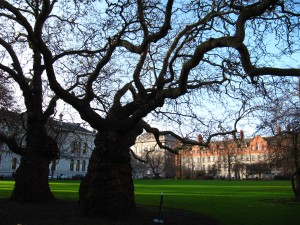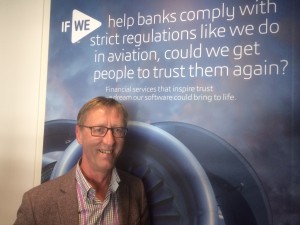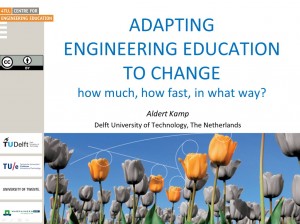![CDIO_coated_TM [Converted]_jpeg](https://aldertkamp.weblog.tudelft.nl/files/2017/01/CDIO_coated_TM-Converted_jpeg-300x188.jpg) Has it ever been different?
Has it ever been different?
“Engineering Opportunities in a Resource Constrained Future”. When I read this theme of the CDIO European Regional Meeting at Trinity College Dublin on 12-13 January 2017 the very first time, I wondered: “Has it ever been different?” Have we ever had an age where we had an unlimited amount of resources in engineering or engineering education? In my keynote “Adapting engineering education to change” I therefore started with the question which resource constrains us most in higher engineering education. Is it the growing number or attitude of students, the number or capabilities of staff, or the facilities to accommodate all students or new pedagogy? In the end of course everything can be expressed in terms of money. But I believe the major constraining resource is TIME: the consensus is that we as engineering educators can’t keep up with the pace of change in engineering knowledge and methods, the changing needs by our graduates, and the emerging technologies in education.
Do we understand what we are doing?
When I look back on the CDIO meeting, the thread of the meeting could easily have been: “we know a lot, but do we also understand it, and do we know how to apply what we know?” The programme sessions addressed, in my own words:
-

Workshop by KTH in which we learned to create a rapid prototype of a BSc and MSc curriculum, assigning different types of research-oriented activities (the coloured patches in the photo) to the most appropriate lecturing periods, taking interest and knowledge levels of the students into account. Ranging from lecturing about your own research, or research from elsewhere, to research-tutored activities such as inviting guest lectures, learning to write essays or discuss papers, doing research-based projects, knowledge construction and learning about research methods, to the learning of existing insights (new to students) and discovery-oriented work (new to the discipline).
understanding engineering design processes better, by instrumenting and modeling such processes, in order to understand how to accelerate innovation processes, and how to teach that;
- understanding creativity better by modeling it as a multidimensional construct, and using metaphors, in order to better embed creativity in our education;
- understanding that the same motivating factors are perceived very differently by students and teachers, in order to make teaching and learning more rewarding and successful by using the motivating factors in a more sensible way;
- understanding how research methods and results in engineering and technology can be embedded more effectively and in a structured way in our curricula;
- understanding the complexity of large-scale change in engineering programmes by using a comprehensive heuristic, developed by Maartje van den Boogaard (on behalf of the Dutch 4TU.Centre fore Engineering Education), using real data from major curriculum reconstructions in the universities of Delft, Eindhoven and Twente,whose report is available here.
- awareness that Blockchain technology (currently primarily known for its Bitcoin) might in future be adopted by universities as an integrated database application that cannot be corrupted and can be used for personalised learning, accreditation, administration, registration, and lots of other educational matter: the development of a global higher education Blockchain is already on its way.
- awareness that the changes in society and technology create enormous amounts of questions and challenges for (engineering) education.
Keynote presentations about Design process and Innovation, Creativity, and Adapting Education
In the keynote “Instrumenting the design process and nucelating regional ecosystems to acceleratie innovation”, Dr. Ade Mabogune of Stanford University pointed out that the ultimate resource for future engineering is group work, human interrelation and character. His message was that engineers and designers will only succeed in their career if they master strong collaborative skills. He elaborated on the metaphor that teams do not behave as particle theories but electromagnetic fields. Social connectivity has always been important but will gain prominence to generate money, share knowledge and thoughts, and fuse innovations. He demonstrated how he had been able to “measure” design processes and use that knowledge to better organise and coach design teams by developing and communicating through a language of symbols that tells the story of engineering design thinking. He also said:
“Innovation happens when ideas have sex. If we want universities to be leaders of innovation we should create more brothels in universities.”
Which, by the way, reminded me of another quote from MIT professor Slocum, quite some time ago, about innovation:
“Innovation can’t be structured. It is like love making. If it has to be efficient, it won’t work”
Anyway, innovation is hot and sexy nowadays. Also in my own keynote I made the statement that Innovation is one of the three cornerstones for a successful and future-proof engineering curriculum.

The beautiful campus of Trinity College Dublin where the CDIO European Regional Meeting 2017 was held.
The keynote by Kathryn Jablokow of Pennsylvania State University was about “Rethinking the metaphor for design creativity.” She stressed that, in a future with increasingly limited resources and expanding requirements, there will be a premium on cleverer and better ways of delivering products and services. Engineers and designers who can manage the creative process well to deliver those products and services will be in high demand. She said that it is therefore essential to better understand creativity, and try to model it for success and failure prediction of teams (or even married couples). She explained different models for understanding and managing creative processes more effectively. She broke the multidimensional construct Creativity down into Opportunity, Motive, Creative Level and Creative Style. In many cases creativity in teams could be significantly enhanced when the diversity in individual creativity styles and levels would be explicitly addressed, appreciated and better exploited. These look interesting insights to me, and I wonder how we could make engineering students better aware of this?
In the plenary panel session all keynote speakers and the provost of Trinity College Dublin talked about “Educating technologists for a resource constrained future.” The thread in this discussion was the development of the interdisciplinary E3 Institute at Trinity College Dublin, where E3 stands for Engineering, Energy, Environment. It will become a majore place where students will learn the develop interdisciplinary skills. Also here it was addressed how difficult it will be to achieve change by changing the traditional minds in the faculty who are used to traditional thinking in monodisciplines. “We have to start a new breed of faculty,” one panel member said. “We should hire more aliens as faculty”, said another.

The panel expressed its doubts whether research universities, mostly arranged in mono-disciplinary silos, would survive the near future when they neglect the trend to more multi- and interdisciplinary engineering and science. The panel expected that more or less “context free” teaching of abstract engineering sciences will soon be pastime. Strong links with the authentic world will become a necessity . The panel also noticed a positive strengthening trend about engineering: the engineering discipline is appreciated as a “house of safety”, considering the terminologies of financial engineering, stress testing of banks, etcetera. But I feel I have to make a side remark here. Are not it engineers, “rocket scientists”, the so-called quants, who develop algorithms that are used in the trading robots on the stock markets, that are so far beyond the layman and can only be understood by nobody else than themselves? That aspect was nót mentioned by the panel. It remembered me to my visit to Dassault Systemes in Paris a couple of months ago, where my attention was drawn by the above poster, relating regulations in aviation to banking.
My keynote speech on behalf of the 4TU.Centre for Engineering Education (4TU.CEE), about “Adapting Engineering Education to Change”, addressed the VUCA world, the impact on the engineering profession, the Millennial generation of students, the impact on engineering education, different engineering profiles and possible ways to add more DIY (Do It Yourself) ethic in programmes. From the reactions I concluded the presentation was well received. “A thought provoking presentation on millennial and 21st century curriculum in engineering education”, is what tweets said. Emails and requests for the slides or visits to come and inspire staff, mentioned “A great synthesis work and coherent visions, excellent work”. I have made the slides available here, on the website of 4TU.CEE where you may find other interesting practices and theories as well that you may use for your benefit.
Workshop on Motivation
I found the workshop session about “Designing Courses for Motivation” by KTH Stockholm particularly interesting. From available literature and ongoing research at KTH I learnt that big differences exist between what teachers and students think, about what factors motivate and demotivate students to learn. In the session we also discussed Daniel Pink’s book “Drive” after watching [youtube video “The surprising truth about what motivates us”]. Everytime I see this video I wonder why so-called bonus points, that many of our lecturers tend to award to stimulate students to perform an activity in a course, still seem to do their job. The session also highlighted the so-called Temporal Motivation Theory, relating the factors that make up Motivation:
Motivation = (Expectancy of success * Value)/(Impulsiveness * Delay), where Value is a measure of purpose, Impulsiveness of how easy distractable a student is, and Delay a measure of the effect of a delay of reward, i.e. if there is no repercussion then the motivation to act drops. Motivation can thus be manipulated by controlling each of these factors in education or profession.
Further interest?
Should you have an interest in a specific subject of this CDIO European Region meeting programme, do not hesitate to contact me. On your request I can establish the contact between you and the session leader. The workshops on Online Learning in Engineering Education, Change Management in Engineering Programmes, and my keynote and panel session contribution were all supported by our 4TU.Centre for Engineering Education. Further interest? Please contact!
The next event of the CDIO network will be the 13th International CDIO Conference in Calgary, Canada between June 18-22, 2017. The theme will be “Engineering Education in the Digital Age”. More information is available here. Everybody, CDIO member or not, is invited to join this inspiring event.



